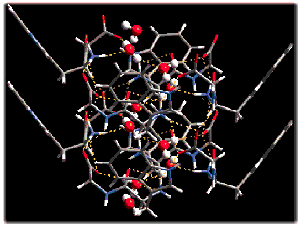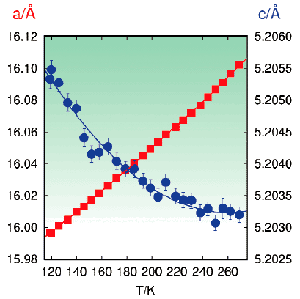- Home
- Users & Science
- Scientific Documentation
- ESRF Highlights
- ESRF Highlights 2000
- Chemistry
- Uniaxial Negative Thermal Expansion of Tryptophylglycine Monohydrate
Uniaxial Negative Thermal Expansion of Tryptophylglycine Monohydrate
Crystal engineering has attracted increasing interest in the past few years. This subject is concerned with the design of solids with specific, controlled properties. One such property is negative thermal expansion (NTE) in which the crystal expands along one or more axes as the temperature is lowered. Several inorganic materials displaying NTE are known [1], but the number of organic examples is very limited. Here we present one such example, tryptophylglycine monohydrate, TrpGly·H2O, a dipeptide.
We solved the structure of this compound using single crystal diffraction data collected at the Swiss-Norwegian Beamlines (SNBL, BM1A) on a crystal measuring only 20x30x180 µm. Focussing optics and a MAR345 imaging-plate detector were used for the experiment. In spite of the small sample size, very high-quality data could be collected both at room temperature and 120 K. The structure refined to very satisfying agreement factors (R1(all) < 3.3 % at both temperatures), fully competitive with high-quality laboratory data on normal-sized samples.
The tetragonal crystal structure displays a helical assembly of peptide molecules connected through extensive hydrogen bonding (Figure 18). This peptide helix encloses a water helix, which is linked to the peptide framework by hydrogen bonds. The water helix is partially ordered at both temperatures with one preferred site. The occupancy of this site increases upon lowering the temperature, but has not reached full occupation at 120 K.
 |
Fig. 18: Helical columns in the crystal structure of TrpGly·H 2O. The water molecules are shown by ball-and-stick while the dashed yellow lines denote hydrogen bonds. Note the columnar structure that is parallel to the c-axis.
|
We investigated the thermal expansion using powder diffraction and the same imaging plate detector. This method allows for rapid characterisation of phase transitions and/or thermal expansion [2]. In the present case, the total measuring time for 25 temperatures was only 75 minutes. The evolution of the lattice parameters with temperature is shown in Figure 19. The thermal expansion along c, the helical axis, is negative below room temperature and becomes even more negative as the temperature is lowered. At all temperatures, the thermal expansion along a and b is positive and of larger amplitude than that along c, which leads to positive volume thermal expansion. We speculate that this uniaxial negative thermal expansion is caused either by large amplitude motions perpendicular to the helical axis or is due to the water's ordering.
 |
Fig. 19: Thermal expansion of TrpGly·H 2O. It is negative along c.
|
In summary we have shown that bending magnet beamlines are perfectly capable of delivering high quality data on very small organic crystals and that TrpGly·H2O displays uniaxial NTE. Future work will probe the detailed mechanism behind this unusual behaviour.
References
[1] J.S.O. Evans, J. Chem. Soc., Dalton Trans., 3317-3326 (1999).
[2] P. Pattison, K.D. Knudsen, R. Cerny and E. Koller, J. Synch. Rad., 7, 251-256 (2000).
Principal Publication and Authors
H. Birkedal (a), D. Schwarzenbach (a) and P. Pattison (a), to be published.
(a) University of Lausanne (Switzerland)



